2. 贺州学院, 广西碳酸钙资源综合利用重点实验室, 广西贺州 542899;
3. 贺州学院, 贺州市微波应用技术重点实验室, 广西贺州 542899
2. Guangxi Key Laboratory of Calcium Carbonate Resources Comprehensive Utilization, Hezhou University, Hezhou, Guangxi, 542899, China;
3. Hezhou Key Laboratory of Microwave Application Technology, Hezhou University, Hezhou, Guangxi, 542899, China
微波是一个频段范围内的电磁波。自1888年海因里希·鲁道夫·赫兹验证电磁波的存在之后,科学家们对电磁波开展了深入的研究并不断获得新发现,从而开发出新的应用技术[1]。微波作为电磁波中的一种短波,最早应用于雷达和通信领域,目前普遍将频率为300 MHz到300 GHz(即波长1 mm到1 m)的电磁波定义为微波。研究发现在不同的传输介质中,微波会呈现出不一样的穿透、反射和吸收等特性,从电子学和物理学角度而言,微波主要表现为强穿透性、选择加热性、低热惯性、光声相似性、非电离性和信息性。
1945年,美国的雷达工程师斯彭塞发现了微波的热效应,很快第一个利用微波热效应的专利诞生。从1947年美国雷声公司的第一个微波炉——雷达炉的应用到其商品化花了大概40年,直到20世纪90年代,随着控制技术、传感技术的不断提高和成熟,微波炉的应用得以普及。考虑到军事、雷达、通讯方面的因素,通用的微波加热专用频率主要有(915±25) MHz、(2 450±50) MHz、(5 800±75) MHz和(22 125±125) MHz,其中2 450 MHz已经在民用方面有较广的普及。随着微波应用领域的持续技术创新与突破,915 MHz也逐渐被应用于工业化生产,尤其是在材料工业应用领域。当前,国内外微波应用技术已发展成为一门极具前途和发展前景的新技术。本文以材料工业应用领域为例,探索剖析微波应用的技术创新进展,并对其发展趋势进行展望。
1 微波及其应用特点微波的应用主要是利用微波发生器将电能转化为电磁能,电磁能在一定条件下作用于吸波介质并转化为热能,即微波热效应,其主要机理是微波与物质分子相互作用并被吸收而产生热。与红外加热、高频加热及其他传导加热方式相比,微波应用特点表现如下:一是它可以深入物体内部,属于内生热,不依赖热传导,可瞬时加热,速度快且节能,热转换效率高;二是其波长短,易集中和防护,即可实现清洁卫生,又不污染环境;三是其容易与其他技术组合,可以释放出大于叠加的效果,催生许多“微波+N”的耦合技术,并由此产生与微波相关的交叉学科。
2 微波技术在材料领域中的应用与发展前景微波技术通过微波反应器来实现应用,就目前来说,常用的微波反应器类型有箱式、平板式、曲折波导式和辐射式等一种或多种的组合。目前,微波既可用于有机材料也可用于无机材料[2],其在材料领域的应用如表 1所示。
| 材料类型 Type of materials |
典型案例 Typical example |
特点 Characteristics |
相关参考文献 Related references |
| 高分子材料 Polymer materials |
环氧树脂、聚酯、聚氨酯热固性树脂及其复合材料、 橡胶 Epoxy resin, polyester, polyurethane thermosetting resin, rubber |
①相同的诱导聚合反应机理 Same induced polymerization mechanism ②相同的聚合物化学网络结构 Same polymer chemical network structure ③相同的聚合物的物理机械性能 Same physical and mechanical properties | [3-15] |
| 阻燃材料 Flame retardant ma- terials |
有机阻燃剂、无机阻燃剂、阻燃剂接枝、阻燃剂萃 取、木材阻燃处理 Organic flame retardant, inorganic flame retardant, flame retardant grafting, flame retardant extrac- tion, wood flame retardant treatment |
①快速脱除易燃成分 Rapid removal of flammable components ②促进阻燃成分形成 Promote the formation of flame retardant components |
[16-34] |
| 金属材料 Metallic materials |
金属合金、金属粉末冶金材料、难熔金属熔炼、金属 材料焊接 Metal alloy, metal powder metallurgy material, re- fractory metal melting, welding metal materials |
①由原料内部快速加热 Fast heating from inside of raw material ②选择性介电加热的特性 Selective dielectric heating ③材料显微组织、力学性能提升 Good microstructure and mechanical proper- ties ④升温速度快,烧结时间短 High heating rate and short sintering time | [35-60] |
| 贵金属冶金 Precious metal metallurgy |
矿石粉碎、碳热还原氧化物、原料煤的脱硫、贵金属 浸出 Ore crushing, carbothermal reduction of oxides, desulfurization of raw coal and leaching of precious metals |
①降低磨矿成本 Low grinding cost ②提高选矿回收率 High recovery rate of mineral processing ③加快冶金反应速率 Speed up metallurgical reaction rate ④脱硫温度低、反应快、操作简单 The desulfurization temperature is low, the reaction is fast and the operation is simple ⑤浸出速率快、金属回收率高 Fast leaching rate |
[61-70] |
| 陶瓷材料 Ceramic materials |
结构陶瓷、功能陶瓷、燃料电池阴极材料 Structural ceramics, functional ceramics and cath- ode materials for fuel cells |
①选择性介质加热 Selective medium heating ②升温速率随组成而变 Heating rate varies with composition ③超细晶粒结构,宏观性能增强 Ultra fine structure, good macro properties ④瞬时性,烧结时间短 Instantaneous, short sintering time | [71-75] |
| 人造石及板材 Artificial stone and board |
人造大理石、人造石英石、人造花岗岩、其他复合人 造石 Artificial marble, artificial quartz stone, artificial granite, other composite artificial stones |
①选择性介质加热 Selective medium heating ②提高固化反应速率 Increase curing reaction rate ③交联反应更完全 The crosslinking reaction is more complete |
[76-78] |
微波加热技术具有效率高、成本低、性能好、加热速度快等优势,其应用领域极广。当前,微波技术在民用微波炉方面普及率较高,在中国市场,家用商业微波炉品牌及企业有顺德格兰仕、顺德美的、青岛海尔、上海松下、德国西门子、宁波方太、顺德惠而浦、东芝、三洋、日立等十大品牌。2019年总计产能约7 845万台,市场产值约400亿元,截至发文前中关村在线统计数据显示,广东省是85%以上家用商业微波炉的主产地,各微波炉品牌市场占有率情况如图 1所示。
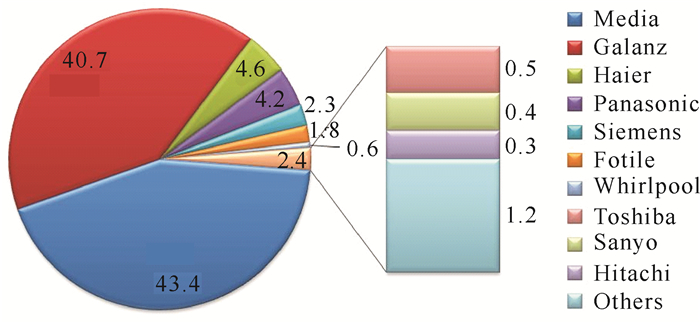
|
| 图 1 中国家用微波炉品牌市场占有率(%) Fig.1 Market share of domestic microwave oven brands in China (%) |
随着工业微波应用技术的发展,越来越多的行业对微波有了新的认识。相比于家用商业微波炉,工业微波装备目前并没有知名品牌,仍处于初级发展阶段。但是,工业微波装备在加热效率、作用功率、加热面积、作用深度、规模化加工等方面具有优势,更适合应用于快速规模化的材料加工,是一种新型的工业加工方式。随着应用场景的变化,所采用的微波频率也有所不同,因此工业微波装备技术被特制化地应用于食品加工、茶叶加工、制药行业、化工行业、陶瓷加工、家具制造、造纸等领域。当前提倡节能环保和工业高质量发展的技术创新氛围,极大地促进工业微波应用技术的快速发展,并打破依靠传统化石能源加工的格局。中国工业微波装备技术产品也是在近几年才逐渐走入市场,其生产厂家主要分布在南京、上海、山东、广州、河南、湖南等地,2019年工业微波装备市场规模达到80亿元。尽管如此,从现有工业微波炉发展状况看,工业微波应用装备技术是一门新兴的科学技术,由于其物理学方面的特性,以及工业应用场景和条件的不同,注定不可能由一种工业微波炉实现多种应用途径,而是根据某个应用领域的特点有针对性地设计和开发。工业微波装备技术可工业化应用的关键核心技术主要表现为对磁控管、微波反应器、电磁屏蔽、电磁兼容技术以及其智能控制系统的设计上。就当前发展状况看,工业微波装备技术与材料之间的作用机理研究仍处于初级阶段,尤其是工业微波装备并没有统一的规范化技术标准和检验检测评价方法,因此推动工业微波装备技术发展仍需要更多社会力量(包括科技领域)的广泛支持。目前,需要推动的内容主要有如下3方面:1)发挥微波基础理论研究对材料应用开发技术创新的支撑作用——从实验室水平的微波作用机制研究,转向结合实践案例对微波基础理论加以探究和验证,并找到材料在微波场中化学反应的基本规律,形成完整的微波材料化学理论体系;2)加大工业微波应用装备的研究与开发——根据不同产品和应用领域对微波装备的要求,整合材料化学、微波理论、电子技术、计算科学、机械设计与制造等多学科专业研发队伍,开展以集成创新为主的工业微波装备技术研发;3)加大工程化技术的应用研究,重点是挖掘工程技术瓶颈问题,构建全新的研究工作形式。从工程化研发中找到根本性理论问题,并对此基础理论开展深入研究,通过对应用技术与基础理论的研究相结合,协同推进微波技术工业化应用快速发展。
3 微波技术在材料工业应用中的创新案例微波在材料工业领域的应用有很多成功案例,本文限于篇幅的影响,重点介绍工业微波炉在人造石材料加工行业取得的进展,以及实施微波应用技术创新的效果和作用。
在人造大理石生产过程中固化大约需要10—15 d,固化反应时间长,是生产中的瓶颈问题。这不仅造成企业大量资金积压在库存上,仓储压力非常大,而且传统的生产过程通常是在敞开的环境下进行,部分未反应物质和溶剂会挥发到大气环境中,从而引起环境污染问题。针对这些问题,丁海兵等[77, 78]组建人造大理石微波固化技术创新团队,经过4年的产学研协同创新,攻克人造大理石微波快速固化装备技术难题,将固化时间缩短至2 h以内,大大提高了生产效率,并成功研发出世界上首台大尺寸不饱和聚酯人造大理石微波快速固化设备。
整个创新研发过程高度整合材料、化工、物理、电子、机械等方面的专业技术人才,并结合生产线实际情况,从微波场电子仿真入手(图 2,3),再经实验工艺验证并修正参数,获得修正装备设计参数。使用电子集成技术绘制装备设计原理图(图 4),通过相关专业专家论证并重新设计加工获得实验样机(图 5),并进行1/6尺寸人造大理石的验证实验。
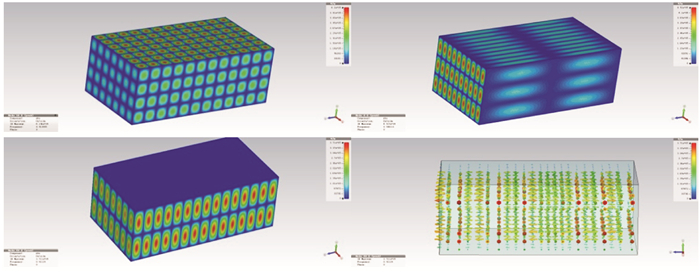
|
| 图 2 未填充石材时固化反应器中的典型工作模式仿真 Fig.2 Simulation of typical working mode in solidification reactor without filling stone |

|
| 图 3 填充人造石介质固化反应器中的典型工作模式仿真 Fig.3 Simulation of typical working mode in the reactor filled with artificial stone |
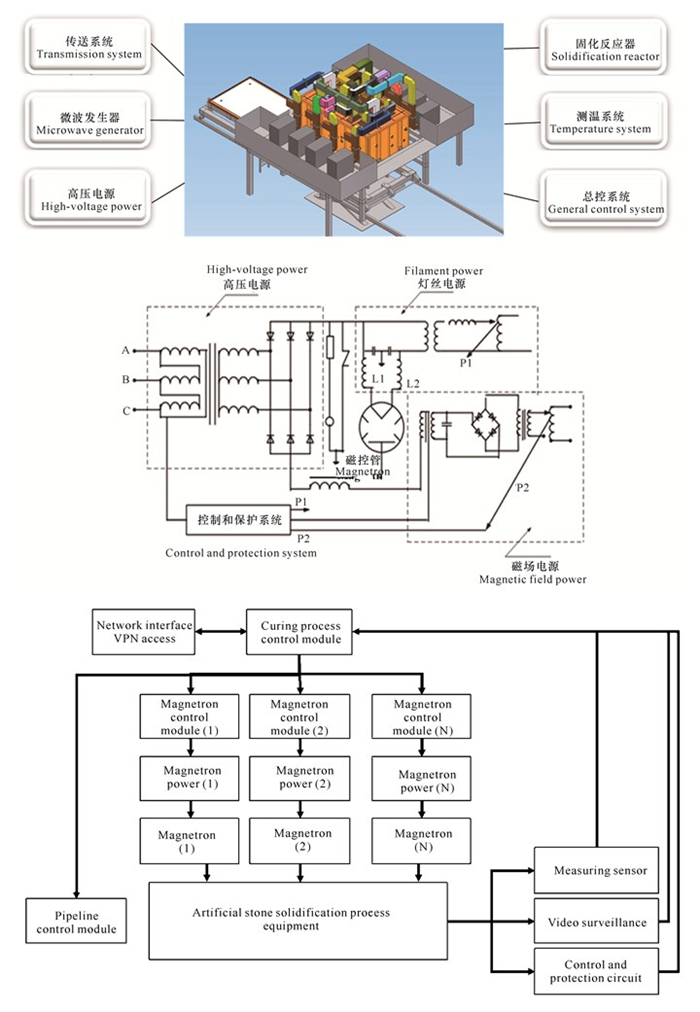
|
| 图 4 微波快速固化人造大理石装备设计原理示意图 Fig.4 Schematic diagram of design principle of microwave rapid curing artificial marble equipment |
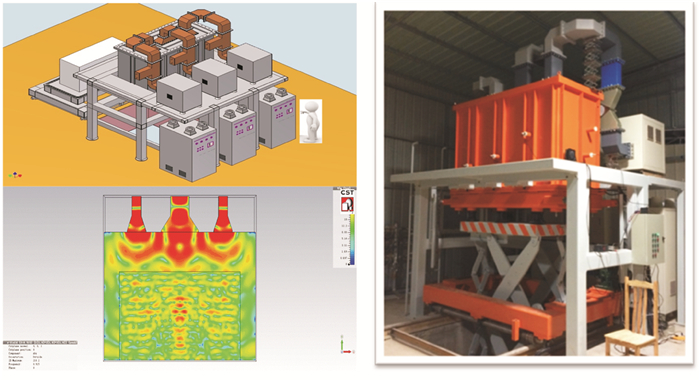
|
| 图 5 微波固化反应实验样机 Fig.5 Experimental prototype of microwave curing reaction |
从实验样机获取工艺参数(如温度、功率、时间以及微波工作机制)后,对比计算机仿真数据后,修改微波场电子仿真条件和参数,完善微波固化装备设计参数,修正装备设计加工参数,并进行装备工程化设计放大,同时开发出大功率高压电源和磁控管,最终获得第一代工程机如图 6所示。
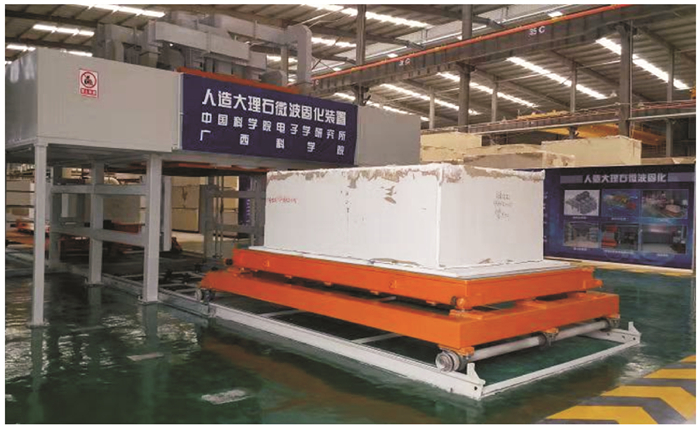
|
| 图 6 第一代微波固化人造大理石工程机 Fig.6 The first generation of microwave curing artificial marble engineering machine |
为进一步验证工程机的工作状况和所生产人造石的质量,技术创新团队用第一代工程机进行多达3 000颗人造石的生产试验(相关人造石部分板材的力学性能如表 2所示),最终石材产品达标率为99.9%,截至目前第一代微波固化人造大理石工程机已生产5 000余颗人造大理石。从表 2中发现利用微波固化装备技术生产的人造大理石材,其机械性能既满足行业标准,又在硬度、弯曲强度等指标有所提高(图 7),尤其是关键指标线性热膨胀系数降低12%,更接近水泥的指标,因此可能实现有机型人造石铺设地面的应用途径。与此同时,为推进微波装备的标准化生产和推广应用,需要谨慎论证微波辐射安全性指标,为此提请广州广电计量检测对其进行现在微波辐射检测,检测最终显示,微波固化装备微波辐射剂量远低于现行国标GBZ 2.2-2007的安全限值,属于安全微波装备产品。
| 报告编号 Report number |
样品 Sample |
弯曲强度 Flexural strength (MPa) |
压缩强度 Compressive strength (MPa) |
热膨胀系数 Coefficient of thermal expansion (×10-5) |
||||||||||||||||
| 1# | 2# | 3# | 4# | 5# | 6# | 7# | 均值 Average |
1# | 2# | 3# | 4# | 5# | 均值 Average |
1# | 2# | 均值 Average |
||||
| SCW20170607 | 3D-A | 27.10 | 29.43 | 29.00 | 27.43 | 27.43 | 27.99 | 28.51 | 28.10 | 96.4 | 98.4 | 99.6 | 96.0 | 95.6 | 97.0 | 1.77 | 1.79 | 1.78 | ||
| SCW20170610 | 4D-A | 29.19 | 28.59 | 29.12 | 28.20 | 28.34 | 29.21 | 27.81 | 28.60 | 99.6 | 101.8 | 96.0 | 99.8 | 100.0 | 99.0 | 1.65 | 1.69 | 1.67 | ||
| SCW20170622 | 3U-C | 28.03 | 27.06 | 25.58 | 28.36 | 27.72 | 28.54 | 29.16 | 27.80 | 91.6 | 99.0 | 95.6 | 96.4 | 90.8 | 95.0 | 1.60 | 1.61 | 1.61 | ||
| SCW20170608 | 4U-C | 30.48 | 29.15 | 30.33 | 30.52 | 30.93 | 30.45 | 29.95 | 30.30 | 103.8 | 102.8 | 98.0 | 99.6 | 103.8 | 102.0 | 1.35 | 1.40 | 1.38 | ||
| SCW20170609 | 3M-A | 28.86 | 26.02 | 28.24 | 28.52 | 28.81 | 28.38 | 28.72 | 28.20 | 91.6 | 96.8 | 94.0 | 88.0 | 98.0 | 94.0 | 1.61 | 1.66 | 1.64 | ||
| SCW20170624 | 4M-A | 28.03 | 27.77 | 27.18 | 28.28 | 28.85 | 28.77 | 28.53 | 28.20 | 100.2 | 102.6 | 96.0 | 100.4 | 107.2 | 101.0 | 1.63 | 1.60 | 1.62 | ||
| SCW20170620 | 3M-C | 28.19 | 27.12 | 27.56 | 27.07 | 27.65 | 28.70 | 27.44 | 27.70 | 97.4 | 97.2 | 94.7 | 96.0 | 99.2 | 97.0 | 1.55 | 1.58 | 1.57 | ||
| SCW20170611 | 4M-C | 25.98 | 27.85 | 27.39 | 27.11 | 26.58 | 27.23 | 26.50 | 26.90 | 100.6 | 99.0 | 99.6 | 100.0 | 99.2 | 100.0 | 1.72 | 1.75 | 1.74 | ||
| SCW20170612 | 3D-C | 28.13 | 25.53 | 25.73 | 26.94 | 26.65 | 25.82 | 26.03 | 26.40 | 98.2 | 99.6 | 97.2 | 98.0 | 99.6 | 99.0 | 1.61 | 1.65 | 1.63 | ||
| SCW20170616 | 4D-C | 28.79 | 29.81 | 28.73 | 28.92 | 27.98 | 27.32 | 28.68 | 28.60 | 101.0 | 99.4 | 96.2 | 95.6 | 102.4 | 99.0 | 1.97 | 1.91 | 1.94 | ||
| SCW20170613 | 3U-A | 27.19 | 28.57 | 28.97 | 28.09 | 28.95 | 28.31 | 28.36 | 28.30 | 98.0 | 94.2 | 98.0 | 95.6 | 95.6 | 96.0 | 1.58 | 1.56 | 1.57 | ||
| SCW20170619 | 4U-A | 28.89 | 30.22 | 27.96 | 29.91 | 30.53 | 29.78 | 29.19 | 29.50 | 101.6 | 104.4 | 103.6 | 84.6 | 99.2 | 99.0 | 1.54 | 1.49 | 1.52 | ||
| SCW20170614 | 3D-B | 28.54 | 28.00 | 28.64 | 27.80 | 27.97 | 27.78 | 28.66 | 28.20 | 96.0 | 95.2 | 96.4 | 94.8 | 94.4 | 95.0 | 1.73 | 7.67 | 1.70 | ||
| SCW20170618 | 4D-B | 29.62 | 29.20 | 31.87 | 30.02 | 29.81 | 31.72 | 30.31 | 30.40 | 103.6 | 103.6 | 99.2 | 104.0 | 104.8 | 103.0 | 1.66 | 1.72 | 1.69 | ||
| SCW20170615 | 3U-B | 28.70 | 28.64 | 27.92 | 28.36 | 28.74 | 28.75 | 28.90 | 28.60 | 96.8 | 98.0 | 95.6 | 98.0 | 100.4 | 98.0 | 1.68 | 1.72 | 1.70 | ||
| SCW20170617 | 4U-B | 30.43 | 29.48 | 29.43 | 29.91 | 30.88 | 31.27 | 29.78 | 30.20 | 98.6 | 101.0 | 100.0 | 99.4 | 99.8 | 100.0 | 1.78 | 1.83 | 1.81 | ||
| SCW20170621 | 3M-B | 27.83 | 28.90 | 28.52 | 27.35 | 29.39 | 29.33 | 28.75 | 28.60 | 86.2 | 96.4 | 88.6 | 94.0 | 91.8 | 91.0 | 1.68 | 1.64 | 1.66 | ||
| SCW20170623 | 4M-B | 27.94 | 27.76 | 25.11 | 26.94 | 28.37 | 26.44 | 28.04 | 27.20 | 102.0 | 102.0 | 104.0 | 101.0 | 100.0 | 102.0 | 1.46 | 1.53 | 1.50 | ||

|
| 图 7 微波固化与传统自然固化生产人造石板材的两个重要指标对比情况 Fig.7 Comparison of two important indexes between microwave curing and traditional natural curing in artificial stone board production |
随着微波快速固化人造石装备技术的深入研发,目前微波固化装备技术已经进入第3代产品的加工设计,其优势主要体现在实现了更大尺寸人造大理石的固化反应(从原有尺寸2.7 m×1.6 m×0.9 m提升到3.2 m×1.6 m×1.2 m),在降低人造石生产成本的同时,装备造价也得以显著降低。与此同时,该技术创新团队还将有机型人造石的微波固化技术转向无机型人造石的微波养护固化技术,进而瞄准产值巨大的混凝土(PC)预制件领域,努力实现微波快速固化关键装备技术从支撑百亿产业转向千亿产业,并最终达成支撑万亿产业的目标。
4 展望综上所述,微波技术作为材料领域创新发展的重要手段,在实践发展中得到了有效应用。虽然最终结果证明其有助于提升材料应用的性能,但深入的理论研究并不多,一些基本科学问题仍有待于深入探析。因此,要结合以往工作经验,根据时代发展各领域提出的各项要求,在工业化过程中加强应用基础研究,以此构建全新的微波材料学发展领域,进而有效展现微波技术的优势和价值。同时案例的成功也验证了以企业为主体,以技术市场需求为导向,通过有针对性的技术装备开发,整合优势学科人才协同开发的技术创新模式是一条行之有效的路径,能极大地推进微波技术在材料工业中的有效应用。
| [1] |
崔岩, 郭成玉, 王晓化, 等. 微波技术在沸石分子筛材料合成中的应用研究进展[J]. 工业催化, 2016, 24(3): 1-9. |
| [2] |
孙凤玲. 微波技术在金属材料制备中的应用现状研究[J]. 中国高新区, 2018(9): 24. |
| [3] |
MIJOVIC J, WIJAYA J. Comparative calorimetric study of epoxy cure by microwave vs thermal energy[J]. Macromolecules, 1990, 23(15): 3671-3674. DOI:10.1021/ma00217a021 |
| [4] |
WEI J, HAWLEY M C, JIANGHUA W, et al. Comparison of microwave and thermal cure of epoxy resins[J]. Polymer Engineering and Science, 1993, 33(17): 1132-1140. DOI:10.1002/pen.760331706 |
| [5] |
WEI J, HAWLEY M C, DEMEUSE M T. Kinetics modeling and time-temperature-transformation diagram of microwave and thermal cure of epoxy resins[J]. Polymer Engineering and Science, 1995, 35(6): 461-470. DOI:10.1002/pen.760350602 |
| [6] |
JORDAN C, GALY J, PASCAULT J P, et al. Comparison of microwave and thermal cure of an epoxy/amine matrix[J]. Polymer Engineering and Science, 1995, 35(3): 233-239. DOI:10.1002/pen.760350303 |
| [7] |
SILINSKI B, KUZMYCZ C, GOURDENNE A. Synthesis under microwaves (2.45 GHz) of polyurethane polymers-Ⅰ.Model study from diisocyanate and polyethertriol prepolymers[J]. European Polymer Journal, 1987, 23(4): 273-275. DOI:10.1016/0014-3057(87)90147-9 |
| [8] |
JULLIEN H, VALOT H. Polyurethane curing by a pulsed microwave field[J]. Polymer, 1985, 26(4): 506-510. DOI:10.1016/0032-3861(85)90149-1 |
| [9] |
GUPTA V B, DRZAL L T, RICH M J, et al. The temperature-dependence of some mechanical properties of a cured epoxy resin system[J]. Polymer Engineering and Science, 1985, 25(13): 812-823. DOI:10.1002/pen.760251305 |
| [10] |
贡健. 微波连续硫化CR海绵的研究[J]. 橡胶工业, 2001, 48(9): 526-527. |
| [11] |
思明, 纯岭. 汽车用橡胶制品现状和发展动向:上[J]. 中国橡胶, 2000(20): 9-12, 15. |
| [12] |
周淑杰, 王富山. 微波连续硫化海绵橡胶密封条的研制[J]. 辽宁化工, 2001, 30(4): 149-150. |
| [13] |
胡建人. 微波快速烘干硅胶的生产工艺研究[J]. 包装工程, 1999, 20(1): 14-18. |
| [14] |
马国远, 郁永章. 热泵微波联合干燥系统研究[J]. 化学工程, 2000, 28(2): 27-30. |
| [15] |
KAIDA B K, 徐 天华. 利用微波干燥测定胶乳的干胶含量[J]. 世界热带农业信息, 1992(4): 2-4. |
| [16] |
何映平, 黄建生, 王永洪.天然橡胶微波干燥的研究[R]//海南省第四届科技论坛.海南省第四届科技论坛论文选编.海口: [s.n.], 2007: 179-182.
|
| [17] |
ZHANG L Q, ZHANG M, ZHOU Y H. Synthesis of a-amino phosphate assisted by microwave and its application in polyurethane foam[J]. China Plastics Industry, 2013, 41(12): 103-107. |
| [18] |
KHALIL F. Synthesis and characterization of new flame-retardant poly (arnide-imide)s containing phosphine oxide and hydantoin moieties in the main chain[J]. Journal of Applied Polymer Science, 2006, 102(5): 5062-5071. DOI:10.1002/app.24667 |
| [19] |
张丽芳, 刘建超, 荣华, 等. 铝酸钙的微波合成与表征[J]. 北京石油化工学院学报, 2012, 20(3): 32-35. |
| [20] |
刘霞, 陈志玲, 范晔. 微波辅助合成低水硼酸锌[J]. 无机盐工业, 2007, 39(4): 29-31. |
| [21] |
刘霞, 丁长增, 李杨, 等. 阻燃剂低水硼酸锌的微波水热合成与表征[J]. 无机盐工业, 2013, 45(4): 26-28. |
| [22] |
陈志玲, 刘霞, 孙伟, 等. 纳米级低水硼酸锌的微波合成、表征及应用[J]. 北京石油化工学院学报, 2009, 17(4): 31-35. |
| [23] |
ZHANG Z J, XU C H, QIU F L, et al. Study on fire-retardant nanocrystalline Mg-Al layered double hydroxides synthesized by microwave-crystallization method[J]. Science in China Series B-Chemistry, 2004(6): 488-498. |
| [24] |
周秀华, 章文贡, 肖丽足, 等. 微波辐射阴离子插层类水滑石及其阻燃性研究[J]. 塑料助剂, 2009(2): 24-28. |
| [25] |
赵汉青, 陈春霞, 张宇, 等. 微波晶化法合成柱撑纳米层状双氢氧化物及其对PP阻燃性能的研究[J]. 材料导报, 2010, 24(S2): 180-184. |
| [26] |
ZHU G J, ZHANG L, LUO J, et al. Preparation of na-nosized Sb203 flame retardant by liquid phase homogeneous precipitation method with microwave heating[J]. Chinese Journal of Inorganic Chemistry, 2004, 20(12): 1497-1501, 1376. |
| [27] |
YUAN W H, CHEN H R, CHANG R R, et a1. Synthesis and characterization of NaA zeolite particle as intumescent flame retardant in chloroprene rubber system[J]. Particuology, 2011, 9(3): 248-252. DOI:10.1016/j.partic.2010.05.016 |
| [28] |
于丹琦, 陈国强. 新型磷系阻燃剂对真丝的微波接枝[J]. 丝绸, 2008(8): 24-27. |
| [29] |
牛梅, 王欣, 曾帅, 等. 微波辐照下接枝碳微球阻燃羊毛纤维的结构与性能[J]. 毛纺科技, 2014, 42(1): 61-64. |
| [30] |
赵静然, 张胜, 古晓昱, 等. 尼龙66织物微波法接枝丙烯酰胺的阻燃改性[J]. 印染, 2014, 40(15): 1-4, 30. |
| [31] |
BAYEN S, LEE H K, OBBARD J P. Determination of polybrominated diphenyl ethers in marine biological tissues using microwave-assisted extraction[J]. Journal of Chromatography A, 2004, 1035(2): 291-294. DOI:10.1016/j.chroma.2004.02.055 |
| [32] |
LI Y, WANG T, HASHI Y, et al. Determination of brominated flame retardants in electrical and electronic equipments with microwave-assisted extraction and gas chromatography-mass spectrometry[J]. Talanta, 2009, 78(4/5): 1429-1435. |
| [33] |
LI X D, QI X Y, HAO W X. Application of microwave technology to fire-retarding of wood[J]. Journal of Lianyungang Technical College, 2005, 18(4): 66-68. |
| [34] |
LI X D. Introducing microwave and ultrasonic technology to soaking wood with fire retardants[J]. Chemical Industry and Engineering Progress, 2005, 24(12): 1422-1425. |
| [35] |
MISHRA P, SETHI G, UPADHYAYA A. Modeling of microwave heating of particulate metals[J]. Metallurgical and Materials Transactions B, 2006, 37(5): 839-845. DOI:10.1007/s11663-006-0066-z |
| [36] |
RYBAKOV K I, SEMENOV V E, EGOROV S V, et al. Microwave heating of conductive powder materials[J]. Journal of Applied Physics, 2006, 99(2): 023506-1-023506-9. DOI:10.1063/1.2159078 |
| [37] |
BYKOV Y V, RYBAKOV K I, SEMENOV V E. High-temperature microwave processing of materials[J]. Journal of Physics D:Applied Physics, 2001, 34(13): R55. DOI:10.1088/0022-3727/34/13/201 |
| [38] |
GEDEVANISHVILI S, AGRAWAL D, ROY R. Mi-crowave combustion synthesis and sintering of intermetallics and alloys[J]. Journal of Materials Science Letters, 1999, 18(9): 665-668. DOI:10.1023/A:1006671507193 |
| [39] |
ZHOU G T, PALCHIK O, POL V G, et al. Microwa-ve-assisted solid-state synthesis and characterization of intermetallic compounds of Li3Bi and Li3Sb[J]. Journal of Materials Chemistry, 2003, 13(10): 2607-2611. DOI:10.1039/b303163b |
| [40] |
JOKISAARI J R, BHADURI S, BHADURI S B. Mi-crowave activated combustion synthesis of titanium aluminides[J]. Materials Science and Engineering:A, 2005, 394(1/2): 385-392. |
| [41] |
POLI G, SOLA R, VERONESI P. Microwave-assisted combustion synthesis of NiAl intermetallics in a single mode applicator:Modeling and optimization[J]. Materials Science and Engineering:A, 2006, 441(1/2): 149-156. |
| [42] |
TAKAYAMA S, SAITOU Y, SATO M, et al. Sinte-ring behavior of metal powders involving microwave-enhanced chemical reaction[J]. Japanese Journal Applied Physics, 2006, 45(3A): 1816-1822. DOI:10.1143/JJAP.45.1816 |
| [43] |
PANDA S S, SINGH V, UPADHYAYA A, et al. Effect of conventional and microwave sintering on the properties of yttria alumina garnet-dispersed austenitic stainless steel[J]. Metallurgical and Materials Transactions A, 2006, 37: 2253-2264. DOI:10.1007/BF02586144 |
| [44] |
ANKLEKAR R M, AGRAWAL D K, ROY R. Microwave sintering and mechanical properties of PM copper steel[J]. Powder Metallurgy, 2001, 44(4): 355-362. DOI:10.1179/pom.2001.44.4.355 |
| [45] |
SAITOU K. Microwave sintering of iron, cobalt, nickel, copper and stainless steel powders[J]. Scripta Materialia, 2006, 54(5): 875-879. DOI:10.1016/j.scriptamat.2005.11.006 |
| [46] |
TAKAYAMA S, LINK G, MIKSCH S, et al. Millimeter wave effects on sintering behavior of metal powder compacts[J]. Powder Metallurgy, 2006, 49(3): 274-280. DOI:10.1179/174329006X110835 |
| [47] |
UPADHYAYA A, SETHI G. Effect of heating mode on the densification and microstructural homogenization response of premixed bronze[J]. Scripta Materialia, 2007, 56(6): 469-472. DOI:10.1016/j.scriptamat.2006.11.031 |
| [48] |
SETHI G, UPADHYAYA A, AGRAWAL D. Microwave and conventional sintering of premixed and prealloyed Cu-12Sn bronze[J]. Science of Sintering, 2003, 35(2): 49-65. DOI:10.2298/SOS0302049S |
| [49] |
GUPTA M, WONG W L E. Enhancing overall mecha-nical performance of metallic materials using two-directional microwave assisted rapid sintering[J]. Scripta Materialia, 2005, 52(6): 479-483. DOI:10.1016/j.scriptamat.2004.11.006 |
| [50] |
THAKUR S K, KONG T S, GUPTA M. Microwave synthesis and characterization of metastable (Al/Ti) and hybrid (Al/Ti+SiC) composites[J]. Materials Science and Engineering:A, 2006, 452/453: 61-69. |
| [51] |
WONG W L E, GUPTA M. Development of Mg/Cu nanocomposites using microwave assisted rapid sintering[J]. Composites Science and Technology, 2007, 67(7/8): 1541-1552. |
| [52] |
TUN K S, GUPTA M. Improving mechanical properties of magnesium using nano-yttria reinforcement and microwave assisted powder metallurgy method[J]. Composites Science and Technology, 2007, 67(13): 2657-2664. DOI:10.1016/j.compscitech.2007.03.006 |
| [53] |
UPADHYAYA A, TIWARI S K, MISHRA P. Microwave sintering of W-Ni-Fe alloy[J]. Scripta Materialia, 2007, 56(1): 5-8. |
| [54] |
JAIN M, SKANDAN G, MARTIN K, et al. Microwave sintering:A new approach to fine-grain tungsten-Ⅰ[J]. International Journal of Powder Metallurgy, 2006, 42(2): 45-50. |
| [55] |
PERELAER J, GANS B J, SCHUBERT U S. Ink-jet printing and microwave sintering of conductive silver tracks[J]. Advance Materials, 2006, 18(16): 2101-2104. DOI:10.1002/adma.200502422 |
| [56] |
EBADZADEH T, VALEFI M. Microwave-assisted sintering of zircon[J]. Journal of Alloys and Compounds, 2008, 448(1/2): 246-249. |
| [57] |
ROY R, AGRAWAL D, CHENG J, et al. Full sintering of powdered-metal bodies in a microwave field[J]. Nature, 1999, 399(6737): 668-670. DOI:10.1038/21390 |
| [58] |
SUN X, HWANG J Y, HUANG X, et al. Effects of microwave on molten metals with low melting temperatures[J]. Journal of Minerals and Materials Characterization and Engineering, 2005, 4(2): 107-112. DOI:10.4236/jmmce.2005.42010 |
| [59] |
SIORES E, DOREGO D. Microwave applications in materials joining[J]. Journal of Materials Processing Technology, 1995, 48(1/2/3/4): 619-625. |
| [60] |
CHIU K Y, CHENG F T, MAN H C. A preliminary study of cladding steel with NiTi by microwave-assisted brazing[J]. Materials Science and Engineering:A, 2005, 407(1/2): 273-281. |
| [61] |
PAN E G, RRAVAEV A A. The enhancement of me-tal-to-ceramics adhesion bond under sintering in microwave fields[J]. Advanced Engineering Materials, 2004, 6(1/2): 61-64. |
| [62] |
PUT S, VLEUGELS J, ANNÉG, et al. Processing of hardmetal coatings on steel substrates[J]. Scripta Materialia, 2003, 48(9): 1361-1366. DOI:10.1016/S1359-6462(02)00652-8 |
| [63] |
KINGMAN S W, ROWOSON N A. The influence of mineralogy on microwave assisted grinding[J]. Minerals Engineering, 2000, 13(3): 313-327. |
| [64] |
AMANKWAH R K, KHAN A U, PICKLES C A, et al. Improved grindability and gold liberation by microwave pre-treatment of a free-milling gold ore[J]. Mineral Processing and Extractive Metallurgy, 2005, 114(1): 30-36. |
| [65] |
STANDISH N, WORNER H. Microwave application in the reduction of metal oxide with carbon[J]. Journal of Microwave Power and Electromagnetic Energy, 1990, 25(3): 177-180. DOI:10.1080/08327823.1990.11688126 |
| [66] |
WONG W L E, KARTHIK S, GUPTA M. Develop-ment of hybrid Mg/Al2O3 composites with improved properties using microwave assisted rapid sintering route[J]. Journal of Materials Science, 2005, 40(13): 3395-3402. DOI:10.1007/s10853-005-0419-z |
| [67] |
ROWSON N A, RICE N M. Magnetic enhancement of pyrite caustic microwave treatment[J]. Minerals Engineering, 1990, 3(3/4): 355-361. |
| [68] |
HAYASHI J, OKU K, KUSAKABE K, et al. The role of microwave irradiation in coal desulphurisation with molten caustic[J]. Fuel, 1990, 69(2): 739-742. |
| [69] |
HUANG H J, ROWSON N A. Application of microwave pre-oxidation in improving gold recovery of a refractory gold ore[J]. Rare Metals, 2000, 19(3): 161-171. |
| [70] |
BRADSHAW S M, VAN W E J, DESWARDT J B, et al. Preliminary economic assessment of microwave regeneration of activated carbon for the carbon in pulp process[J]. Journal of Microwave Power and Electromagnetic Energy, 1997, 32(3): 131-144. DOI:10.1080/08327823.1997.11688333 |
| [71] |
FORD J D, PEI D C T. High temperature chemical processing via microwave absorption[J]. Journal of Microwave Power and Electromagnetic Energy, 1967, 2(2): 61-64. |
| [72] |
WALKIEWICZ J W, KAZONICH G, MCGILL S L. Microwave heating characteristics of selected minerals and compounds[J]. Miner Metall Process, 1988, 5(1): 39-42. |
| [73] |
高建峰, 刘亚飞, 刘杏芹, 等. 微波固相反应合成La1-xSrxCoO3阴极材料的研究[J]. 硅酸盐学报, 2002, 30(S): 75-78. |
| [74] |
李海英, 翟秀静, 符岩, 等. 锂离子电池正极材料LiCoO2的微波合成及结构表征[J]. 分子科学学报, 2002, 18(4): 199-203. |
| [75] |
翟秀静, 符岩, 刘忠文, 等. 微波合成固体氧化物燃料电池阴极材料La1-xSrxMnO3的研究[J]. 材料与冶金学报, 2002, 1(4): 294-296. |
| [76] |
任奎浩, 孙席久.一种用隧道式微波加热装置固化树脂型人造石的方法: 108069638A[P].2018-05-25.
|
| [77] |
丁海兵, 丁耀根, 高冬平, 等.利用微波加热固化人造石的方法: 104987126A[P].2015-10-21.
|
| [78] |
丁海兵, 唐亮, 李伟松, 等. 超大尺寸人造大理石微波快速固化技术研究[J]. 真空电子技术, 2018(1): 52-56, 59. |



